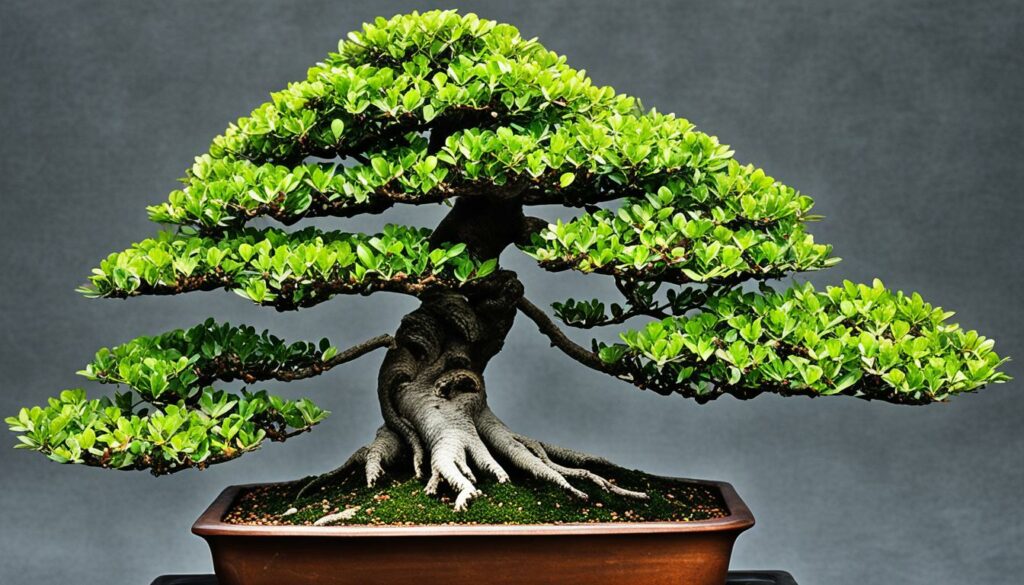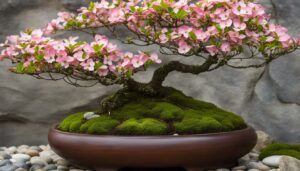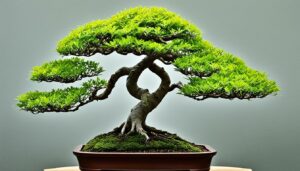Welcome to the world of bonsai tree species! Here, you’ll discover the remarkable beauty and uniqueness of different bonsai varieties. Today, we’ll be focusing on the Cotoneaster species, known for its vibrant berries and delicate flowers. As a bonsai enthusiast, adding Cotoneaster bonsai to your collection will undoubtedly enhance its aesthetic appeal and showcase your expertise in cultivating these charming trees.
Key Takeaways
- The Cotoneaster species is a unique and stunning addition to any bonsai collection
- These bonsai trees are known for their vibrant berries and delicate flowers
- Growing and caring for Cotoneaster bonsai requires specific guidelines, including pruning techniques and pot selection
- Propagation methods enable you to expand your Cotoneaster bonsai collection
- Understanding seasonal changes in Cotoneaster bonsai helps maintain their health and vitality
What is Cotoneaster?
If you’re looking for a stunning flowering bonsai with vibrant berries, Cotoneaster is the perfect choice. This species is a member of the Rosaceae family and includes over 400 species of shrubs and small trees native to temperate regions in Europe, Asia, and North Africa. Cotoneaster is cherished for its charming flowers, delicate foliage, and beautiful berries that come in various colors and sizes, depending on the cultivar.
The Cotoneaster bonsai variety is a popular choice among bonsai enthusiasts for its ornamental appeal and durability. Its flowering pattern, ease of maintenance, and resilience to drought and pests make it an ideal option for beginners and experienced gardeners alike.
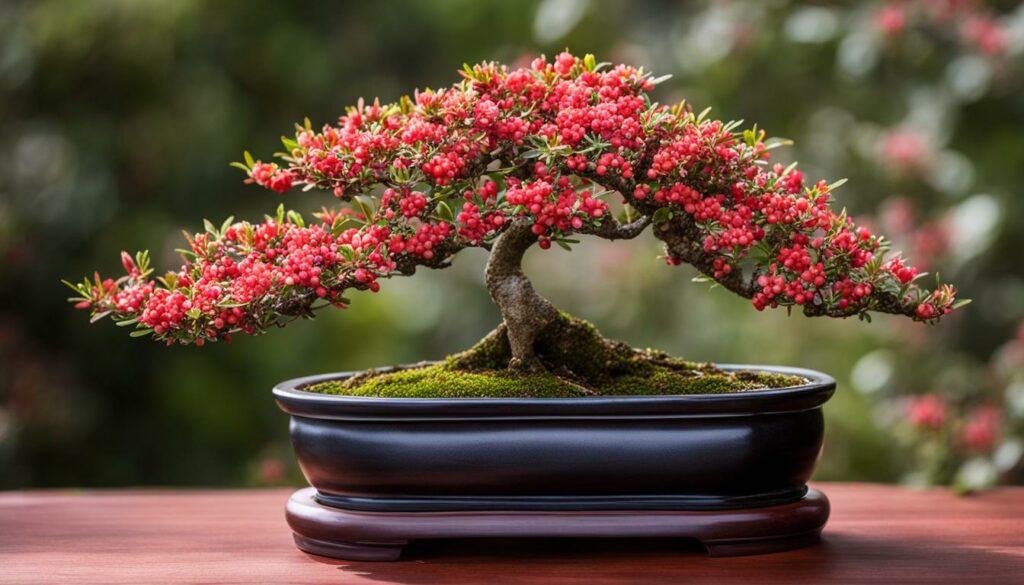
Types of Cotoneaster Bonsai
Cotoneaster bonsai trees can be categorized based on their size, leaves, and berry color:
| Bonsai Type | Size | Leaves | Berry Color |
|---|---|---|---|
| Cotoneaster dammeri | Small | Oval-shaped, dark green | Red |
| Cotoneaster horizontalis | Medium | Small, glossy, deciduous | Red and orange |
| Cotoneaster lacteus | Medium to large | Oval-shaped, dark green and white underneath | Red or black |
| Cotoneaster microphyllus | Small | Round-shaped, dark green, evergreen | Red |
Cotoneaster bonsai trees are versatile and have many styles, including informal upright, slanting, cascade, and semi-cascade. You can experiment with different styles to create a distinctive and aesthetically pleasing composition.
Overall, Cotoneaster bonsai is a fantastic option if you’re looking for a beautiful, low-maintenance bonsai with stunning flowers and berries. With proper care, this species can thrive and bring joy to your gardening endeavors for years to come.
The Beauty of Cotoneaster Bonsai
Looking for a mesmerizing and easy-to-care-for bonsai tree? Consider the Cotoneaster bonsai species, notable for their stunning aesthetic appeal and charming features.
One of the most striking aspects of Cotoneaster bonsai trees is their vibrant berries. These tiny fruits come in an array of colors, including shades of red, orange, and black, adding a bright and cheerful touch to any indoor or outdoor space. The berries are also abundant, creating a lush and appealing visual effect.
But it is not just the berries that make Cotoneaster bonsai trees so beautiful. They also have delicate and charming flowers that bloom in early summer, featuring hues of pink and white. The flowers add a lovely touch of elegance and grace to the overall appearance of the tree.
Together, the vibrant berries and delicate flowers make the Cotoneaster bonsai species a charming and aesthetically pleasing option for any bonsai enthusiast.
Cotoneaster Bonsai Features
| Feature | Description |
|---|---|
| Vibrant Berries | Abundant, colorful fruits in shades of red, orange, and black. |
| Delicate Flowers | Graceful and charming blooms in pink and white. |
Take a moment to appreciate the beauty of a Cotoneaster bonsai tree by adding one to your collection today!
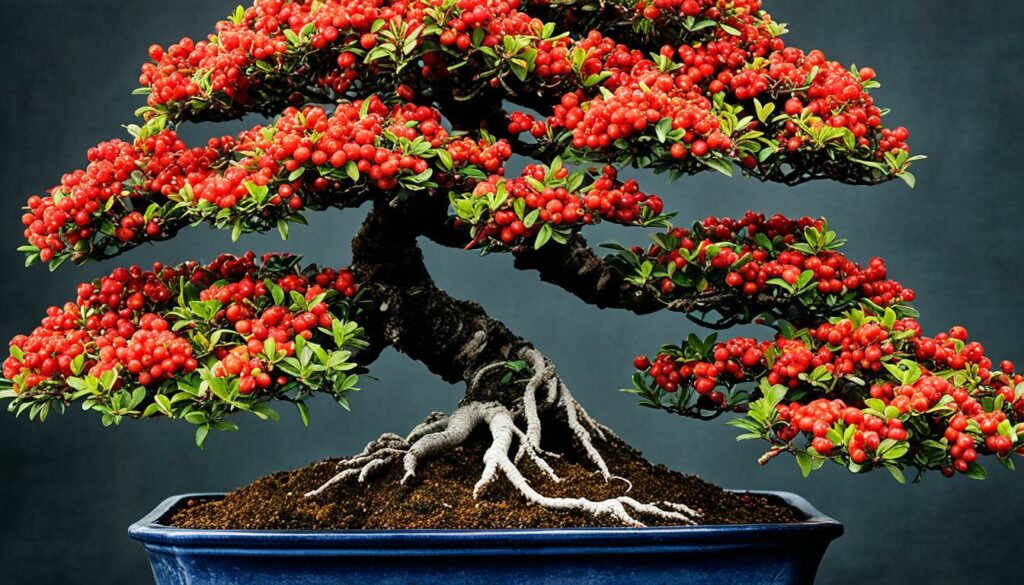
Growing and Caring for Cotoneaster Bonsai
When it comes to growing and caring for your Cotoneaster bonsai, taking a few essential steps can help ensure healthy growth and optimal appearance.
Watering
Cotoneaster bonsai trees should receive moderate watering, ensuring that the soil is moist but not saturated. In dry environments, it may be necessary to water once or twice a day, while in more humid conditions, once every other day may suffice. Always allow excess water to drain out of the pot to prevent root rot.
Pruning
Regular pruning is necessary to maintain the shape and appearance of your Cotoneaster bonsai. It is recommended to prune during the early spring or fall seasons using sharp and sterile tools. When pruning, remove any dead, damaged or diseased branches to promote healthy growth.
Soil Requirements
Cotoneaster bonsai thrive in well-draining soil, with a pH range between 6.5 and 7.5. A suitable mix for these trees should include equal parts of sand, peat moss, and potting soil.
Sunlight Exposure
Cotoneaster bonsai grow best in full or partial sunlight. While these trees can handle some shade, it’s crucial to provide them with at least 6 hours of sunlight per day for optimal growth and health.
Fertilization
Regular fertilization can help ensure healthy growth and maximize the appearance of Cotoneaster bonsai trees. Use a balanced fertilizer during the growing season, applying it once every two weeks.
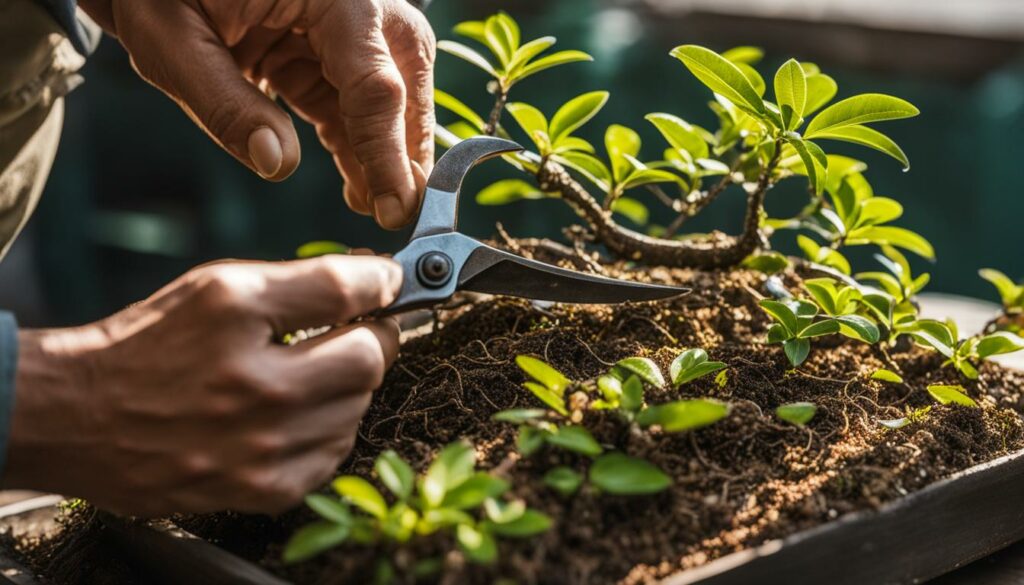
“Taking care of your Cotoneaster bonsai tree can be a very rewarding experience. With a little patience and proper care, your tree can flourish into a beautiful and healthy addition to your bonsai collection.”
Pruning Techniques for Cotoneaster Bonsai
If you want your Cotoneaster bonsai tree to thrive, you need to learn how to prune it correctly. Some key points to keep in mind when pruning your tree are:
Cut at the Right Time:
It’s essential to prune your Cotoneaster bonsai during its dormancy period. Pruning during this stage prevents the tree from losing excessive sap, bringing optimal results.
Use the Right Tools:
A clean cut prevents disease or damage. You’ll need to use clean, sharp pruning shears, allowing for smooth and accurate pruning that won’t harm your tree.
Remove Debris:
Take care to remove any debris created during the pruning process. This debris can be a breeding ground for damaging pests or harmful bacteria.
When pruning your Cotoneaster bonsai, always remove any weak and diseased branches. Using detailed pruning techniques, remove any excess growth or branches that are creating an unmanageable aesthetic. By pruning correctly, your Cotoneaster bonsai will have an appealing shape, creating visual interest with its vibrant berries and delicate flowers.
Pot Selection for Cotoneaster Bonsai
Congratulations on growing your Cotoneaster bonsai, now it’s time to choose the perfect pot to display it in all its beauty. The right pot should provide stability, encourage growth, and showcase your tree’s features, while still looking cohesive with your overall aesthetic.
Consider the size of your bonsai when selecting a pot. Your pot should be slightly larger than the root system to provide enough space for growth. Cotoneaster bonsai trees usually grow to a height of 30cm, so opt for a pot with a diameter of around 15-20cm.
The shape of the pot is also important. Bonsai pots come in various shapes, such as oval, rectangular, and round. Consider the shape of your Cotoneaster bonsai to select a pot that complements its appearance.
Material is another consideration when it comes to pot selection. Ceramic pots are a popular choice as they provide excellent insulation and protect the roots from extreme temperatures. They also look beautiful and come in various colors and patterns. Plastic pots are also suitable, particularly if you live in a hot, dry climate, as they don’t dry up as quickly as ceramic pots.
Finally, aesthetic compatibility is key when selecting a pot. Choose a pot that complements the color and style of your bonsai tree. A pot with earthy tones like brown, beige, or green can add a natural feel to your display, while a colorful pot can add a pop of vibrancy.
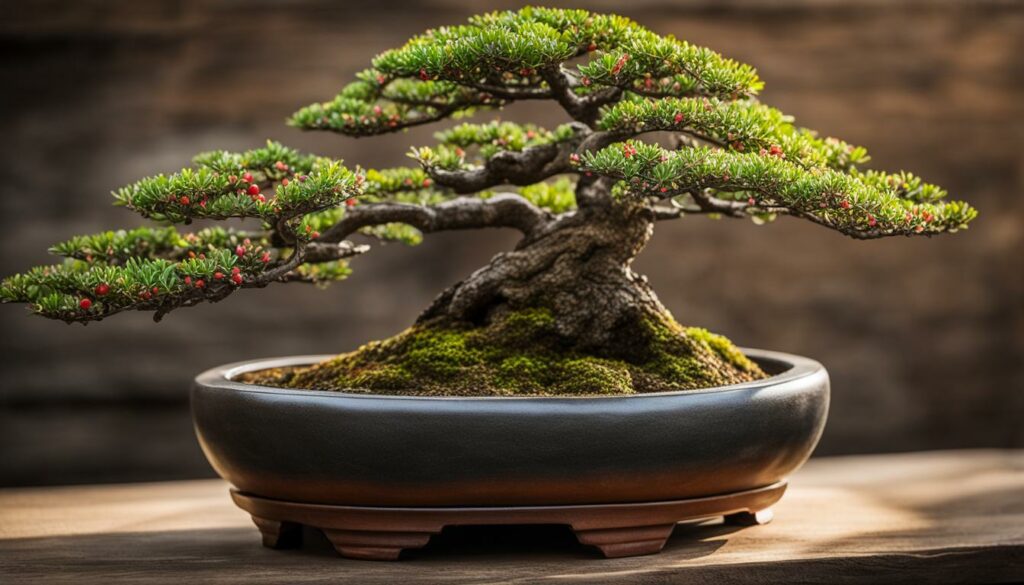
Remember that pot selection is an essential factor in overall bonsai design. Take the time to consider your options and choose the perfect pot for your Cotoneaster bonsai, giving it a home that accentuates its features and helps it thrive.
Propagation of Cotoneaster Bonsai
If you’re looking to expand your bonsai collection, propagating Cotoneaster bonsai is a great way to go. There are a few methods you can choose from, depending on your level of expertise and available resources.
Seed Germination
Starting from seed is an affordable and rewarding way to propagate Cotoneaster bonsai, but it can take longer to see results. The seeds need to be stratified, or exposed to cold temperatures, for a few months before they will germinate. Once the seeds have stratified, you can sow them in a well-draining, nutrient-rich soil mix and keep them moist and warm until they sprout.
Cuttings
Cuttings are an effective way to propagate Cotoneaster bonsai, especially for beginners. Take a 5-7 inch cutting from a healthy Cotoneaster bonsai tree, making a clean cut at a 45-degree angle just below a node. Remove the leaves from the bottom third of the cutting and dip the cut end in rooting hormone. Plant the cutting in a well-draining, moist soil mix and keep it in a bright, warm, and humid location until it roots.
Air Layering
Air layering is a more advanced propagation technique for Cotoneaster bonsai, but it can yield impressive results. This method involves wrapping a section of the trunk with damp sphagnum moss and then covering it with plastic wrap to create a moist and conducive environment for roots to grow. Once the new roots have formed, cut the section off and plant it in a suitable soil mix.
Regardless of which propagation technique you choose, it’s important to ensure proper care and maintenance of the new Cotoneaster bonsai tree to help it thrive.
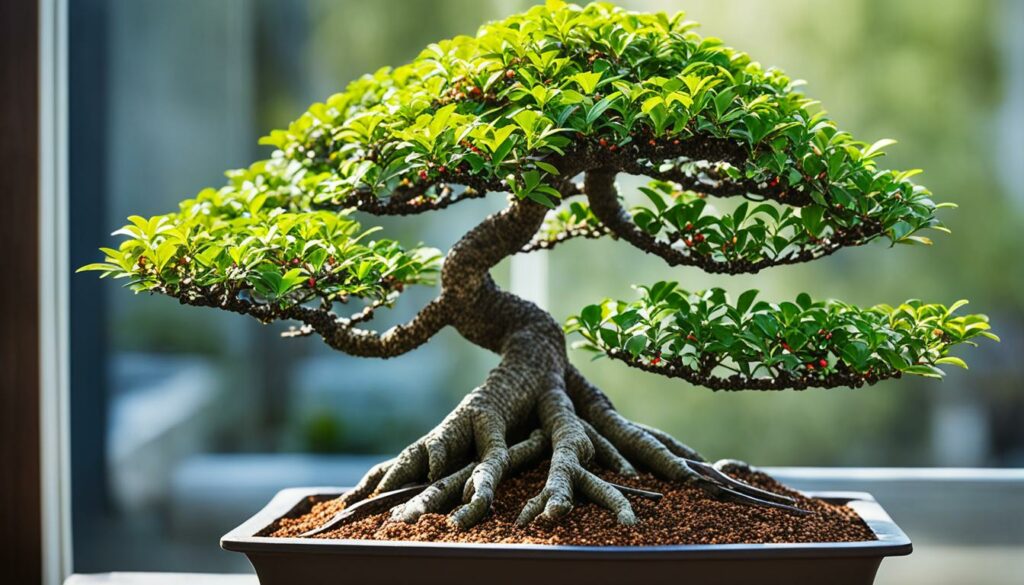
Common Pests and Diseases of Cotoneaster Bonsai
Cotoneaster bonsai trees are susceptible to various pests and diseases that can affect their health and appearance. Identifying the problem early and applying the appropriate treatment is crucial in preventing further damage. Here are some common pests and diseases to watch out for:
| Pests | Symptoms | Treatment |
|---|---|---|
| Spider mites | Yellowing leaves, fine webs on leaves and branches | Remove affected leaves, apply insecticidal soap or neem oil |
| Aphids | Curling leaves, distortions, sticky residue on leaves | Spray with water, apply insecticidal soap or neem oil |
| Caterpillars | Holes in leaves, droppings on the soil | Remove by hand, apply Bacillus thuringiensis |
| Diseases | Symptoms | Treatment |
|---|---|---|
| Root rot | Brown or black roots, wilted leaves, yellowing | Improve drainage, repot with fresh soil, apply fungicide |
| Powdery mildew | White powder on leaves and branches | Remove affected leaves, improve air circulation, apply fungicide |
| Leaf spot | Sunken brown spots on leaves | Remove affected leaves, improve air circulation, apply fungicide |
Preventive measures such as proper watering, avoiding over-fertilization, and regularly cleaning and inspecting your Cotoneaster bonsai can help minimize the risk of pest and disease outbreak. However, if your tree does become infected, swift and appropriate action can save it from further harm.
Styling and Designing Cotoneaster Bonsai
Styling and designing Cotoneaster bonsai is a rewarding process that allows you to create a unique and visually appealing tree. The first step in styling your Cotoneaster bonsai is to consider the tree’s natural characteristics, such as the shape of its trunk, root structure, and foliage.
One of the key design principles for Cotoneaster bonsai is simplicity. Avoid overcrowding the tree with too many branches or foliage, and aim to create a balanced composition with open spaces between the branches. Another essential aspect of styling Cotoneaster bonsai is to consider the tree’s preferred growing pattern. For example, if your Cotoneaster bonsai is a cascading variety, then you may want to incorporate a hanging or waterfall-style design to accentuate this feature.
When designing your Cotoneaster bonsai, keep in mind the overall aesthetic you wish to achieve. Cotoneaster bonsai trees are versatile, and their delicate flowers and vibrant berries provide ample opportunities for creative expression. Consider incorporating natural elements such as rocks or moss to complement your Cotoneaster bonsai’s overall design.
Cotoneaster Bonsai Styling Techniques:
There are several techniques for styling Cotoneaster bonsai trees. Some of the most popular techniques include:
| Technique | Description |
|---|---|
| Broom Style | The Broom Style involves creating a balanced, symmetrical tree with a straight trunk and branches that radiate outwards in a broom-like fashion. This style is particularly suitable for Cotoneaster bonsai trees with thick trunks and fine foliage. |
| Informal Upright Style | The Informal Upright Style involves creating a tree with a slightly curved trunk and asymmetrical branches that mimic the natural growth pattern of the tree. This style is ideal for Cotoneaster bonsai trees with a slender trunk and delicate foliage. |
| Cascade Style | The Cascade Style involves creating a tree with a long, cascading trunk that hangs below the pot’s rim. Cotoneaster bonsai trees with a cascading growth pattern are perfect candidates for this style. |
| Slanting Style | The Slanting Style involves creating a tree with a trunk that slants at an angle between 30-60 degrees from the soil line. This style is particularly popular among Cotoneaster bonsai trees with a thick, tapered trunk. |
Experiment with various styling techniques and design principles to create a stunning, one-of-a-kind Cotoneaster bonsai tree.
Cotoneaster Bonsai in Different Seasons
Cotoneaster bonsai trees offer a beautiful display of seasonal changes throughout the year. In spring, these trees produce delicate flowers in shades of pink and white, providing a stunning contrast against their dark green foliage. As summer approaches, the leaves of the Cotoneaster bonsai may turn a lighter shade of green, providing a fresh and airy feel to the overall appearance.
As autumn sets in, the Cotoneaster bonsai tree begins to shine with its colorful berries in shades of red, pink, and orange. These berries add texture and interest to the tree, making it a popular choice among bonsai enthusiasts. In winter, the leaves of the Cotoneaster bonsai may drop, allowing the tree’s graceful structure and branching pattern to shine.
To ensure your Cotoneaster bonsai thrives and showcases its best self in every season, it’s necessary to provide the appropriate care and maintenance, including proper watering, fertilization, and protection from pests and diseases. As each plant has unique needs, keep an eye on your tree’s health and adjust the care as needed throughout the year.
Conclusion
You’ve discovered the unique features of Cotoneaster bonsai trees, including their vibrant berries and delicate flowers, making them a stunning addition to your bonsai collection. Remember to follow proper care guidelines, including watering, pruning, and selecting the appropriate pot, to ensure healthy growth and longevity. By using propagation techniques and styling principles, you can create visually appealing compositions that showcase the changing characteristics of Cotoneaster bonsai trees throughout the seasons. With preventive measures and treatment options, you can also protect your Cotoneaster bonsai from common pests and diseases. Invest in the beauty and potential of Cotoneaster bonsai trees today and enjoy their captivating presence for years to come.
FAQ
What is Cotoneaster?
Cotoneaster is a species of bonsai tree known for its vibrant berries and delicate flowers. It belongs to the flowering bonsai variety.
What makes Cotoneaster bonsai beautiful?
Cotoneaster bonsai trees are admired for their stunning aesthetic appeal. They produce abundant and colorful berries and feature delicate and charming flowers.
How do I grow and care for Cotoneaster bonsai?
To successfully grow and care for Cotoneaster bonsai, you should provide proper watering, pruning, suitable soil, and adequate sunlight exposure. More detailed care tips can be found in the corresponding section.
What pruning techniques should I use for Cotoneaster bonsai?
There are specific pruning techniques tailored for Cotoneaster bonsai trees. These techniques help maintain their healthy growth, shape, and overall appearance. More information is available in the pruning techniques section.
How do I choose the right pot for my Cotoneaster bonsai?
Pot selection for Cotoneaster bonsai involves considering factors such as size, shape, material, and aesthetic compatibility. Detailed guidance on selecting the appropriate pot can be found in the corresponding section.
How can I propagate Cotoneaster bonsai?
Cotoneaster bonsai can be propagated through methods such as seed germination, cuttings, and air layering. These techniques enable bonsai enthusiasts to expand their collection. More detailed information is available in the propagation techniques section.
What are the common pests and diseases that affect Cotoneaster bonsai?
Cotoneaster bonsai may be susceptible to common pests and diseases. It is important to be familiar with preventive measures and treatment options to maintain the tree’s health and vitality. Refer to the section on common pests and diseases for more details.
What are the styling and designing techniques used for Cotoneaster bonsai?
Styling and designing Cotoneaster bonsai involves various techniques that contribute to visually appealing compositions. These techniques allow bonsai enthusiasts to create unique and artistic designs. More information is available in the styling and designing section.
How does Cotoneaster bonsai change throughout different seasons?
Cotoneaster bonsai trees exhibit distinctive characteristics throughout the seasons, including changes in foliage color, flowering patterns, and berry development. This aspect is discussed in detail in the Cotoneaster bonsai in different seasons section.
What are the key takeaways about Cotoneaster bonsai?
Cotoneaster bonsai is a captivating species known for its vibrant berries and delicate flowers. By following the proper care techniques, pruning methods, and pot selection, you can create beautiful and visually appealing compositions. Embrace the seasonal changes of Cotoneaster bonsai and enjoy the beauty they bring to your bonsai collection.
